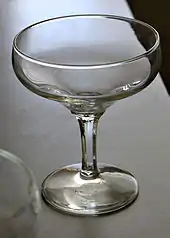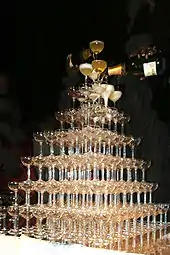Champagne glass
A Champagne glass is a form of stemware designed specifically to enhance the drinking of champagne. The two most common forms are the flute and coupe. In each the stem allows the drinker to hold the glass without affecting the temperature of the drink,[1] making them readily adaptable to consuming other sparkling wines and certain beers. Champagne can also be drunk from a normal wine glass, which allows better appreciation of the flavor, at the expense of accentuating the bubbles less; this has become increasingly popular since the 2010s.[2][3]



Flute
The champagne flute (French: flûte à Champagne) is a stem glass with either a tall tapered conical shape or elongated slender bowl, generally holding about 180 to 300 ml (6.1 to 10.1 US fl oz) of liquid.[4]
The champagne flute was developed along with other wine stemware in the early 1700s as the preferred shape for sparkling wine as materials for drinking vessels shifted from metal and ceramic to glassware.[5] Initially, the flute was tall, conical, and slender;[6] by the 20th century, preferences changed from a straight-sided glass to one which curved inward slightly near the lip.[7]
This inward taper is designed to retain champagne's signature carbonation by reducing the surface area for it to escape.[8] Nucleation in a champagne glass helps form the wine's bubbles; too much surface area allows carbonation to fizzle out quickly. More bubbles create greater texture in the taster's mouth, and a flute's deep bowl allows for greater visual effect of bubbles rising to the top.[8] The flute's narrow cross-section also minimizes the oxygen-to-wine ratio, which enhances both the wine's aroma and taste.[5][lower-alpha 1]
While most commonly used for sparkling wines, flutes are also used for certain beers, especially fruit beers and Belgian lambics and gueuzes.[10][11] The flute shows off the beer's color, and helps gather the aroma for the nose.[11] The champagne flute is distinguished from the pilsner glass, which lacks a stem.[12]
Coupe
The champagne coupe is a shallow, broad-bowled saucer shaped stemmed glass generally capable of containing 180 to 240 ml (6.1 to 8.1 US fl oz) of liquid.[4] Legend has it the shape of the coupe was modelled on the left breast of the French Queen Marie Antoinette, wife of King Louis XVI of France, but the glass was designed in England over a century earlier especially for sparkling wine and champagne in 1663.[13][14][15] The coupe was fashionable in France from its introduction in the 1700s until the 1970s,[16] and in the United States from the 1930s[17] to the 1980s.[14]
Tulip
Champagne is also served in a tulip glass. The white wine tulip is distinguishable from the champagne flute by its wider flared body and mouth.[18] Some oenophiles prefer the tulip glass, as it permits the drinker to get more of the aroma than a traditional flute while the mouth is still narrow enough to avoid quick loss of carbonation.[9][19] The Washington Post food columnist Dave McIntyre has argued that the tulip allows the champagne to move to the middle from the front of the tongue, allowing the wine's flavor to be better expressed.[20] The glass maker Riedel particularly criticizes flutes as one-dimensional, impairing drinkers' ability to appreciate a wine's full range of aromas and taste profiles.[21]
Double-wall stemware
In the 1960s, double-wall stemware was developed to slow the transfer of heat from a drinker's hand to champagne and other beverages.[22] Inner and outer walls are separated by a small gap filled with air, a poor thermal conductor.
References
- Notes
- Sources disagree as to whether the narrow mouth of the flute created to capture a wine's aroma allows sufficient access to appreciate it. Wine writer Victoria Moore argues that the "Flutes are no good for champagne because they are too narrow to allow the odour molecules to gather in a place you can get your nose into."[9]
- Citations
- Cech & Schact 2005, p. 32.
- Teeter, Adam (2014-11-04). "Yes, You Can Drink Champagne Out Of A Regular Wine Glass". VinePair.
- "Is it better to drink Champagne in a regular wineglass instead of a flute?". Wine Spectator. 2014-01-29.
- Giblin 2011, p. 15.
- Sezgin 2010, pp. 72-74.
- Bray 2001, p. 120.
- Walden 2001, p. 9.
- Andrews 2014, pp. 138, 140.
- Moore, Victoria (21 October 2014). "Why settle for a flute when you can savour the whole symphony?". The Daily Telegraph. Retrieved 31 December 2015.
- Jackson 1908, p. 114.
- Villa 2012, p. 373.
- Kohn 2013, p. 175.
- Lamprey 2010, p. 35.
- Boehmer 2009, p. 55.
- Ray 1967, p. 59.
- Liger-Belair 2004, p. 31.
- Andrews 2014, p. 138.
- Robards 1984, pp. 55-56.
- Krebiehl, Anne (January 5, 2016). "Farewell to Champagne flutes in 2016?". Decanter.com. Retrieved November 20, 2016; "The Trouble with Champagne Flutes". Milk Street. Fall 2016. p. 29; Asimov, Eric (November 7, 2019). "Champagne-Style Sparklers, Made in America". The New York Times. Retrieved November 12, 2019.
- McIntyre, Dave (October 1, 2017). "Don;t believe the hype. You don;t need glasses in multiple shapes and sizes to enjoy wine". The Washington Post. Retrieved December 9, 2017.
- Mercer, Chris (November 28, 2013). "My goal is to make Champagne flutes 'obsolete', says Maximilian Riedel". Decanter.com. Retrieved November 20, 2016.
- "Beverage Glasses". The Hardware Retailer. February 11, 1968. p. 183.
Bibliography
- Andrews, Deborah (2014). Shopping: Material Culture Perspectives. Newark, N.J.: University of Delaware Press. ISBN 9781611495188.
- Blume, Lesley M.M.; McFerrin, Grady (2010). Let's Bring Back: An Encyclopedia of Forgotten-Yet-Delightful Chic, Useful, Curious, and Otherwise Commendable Things From Times Gone By. San Francisco: Chronicle Books. ISBN 9781452103501.
- Boehmer, Alan (2009). Knack Wine Basics: A Complete Illustrated Guide to Understanding, Selecting and Enjoying Wine. Guilford, Conn.: Knack. ISBN 9781599215402.
- Bray, Charles (2001). Dictionary of Glass: Materials and Techniques. London: A. & C. Black. ISBN 9780713657920.
- Cech, Mary; Schact, Jennie (2005). The Wine Lover's Dessert Cookbook: Recipes and Pairings for the Perfect Glass of Wine. San Francisco: Chronicle Books. ISBN 9780811842372.
- DeGroff, Dale (2002). The Craft of the Cocktail. New York: Clarkson Potter. ISBN 9780609608753.
- Giblin, Sheri (2011). American Cocktail: 50 Recipes That Celebrate the Craft of Mixing Drinks From Coast to Coast. San Francisco: Chronicle Press. ISBN 9781452110332.
- Jackson, Michael (1908). Michael Jackson's Great Beers of Belgium. Philadelphia: Running Press. ISBN 9780762404032.
- Kohn, Rita (2013). The Complete Idiot's Guide to Beer Tasting. New York: Alpha Books. ISBN 9781615643523.
- Lamprey, Zane (2010). Three Sheets: Drinking Made Easy! 6 Continents, 15 Countries, 190 Drinks, and 1 Mean Hangover!. New York: Villard. ISBN 9780345511584.
- Liger-Belair, Gérard (2004). Uncorked: The Science of Champagne. Princeton, N.J.: Princeton University Press. ISBN 9780691119199.
- Ray, Cyril (1967). In a Glass Lightly. South Brunswick, N.J.: A.S. Barnes. ISBN 9780498074592.
- Robards, Terry (1984). Terry Robards' New Book of Wine: The Ultimate Guide to Wines Throughout the World. New York: G.P. Putnam's Sons. ISBN 9780399129094.
- Sezgin, Pam (2010). "Drinking Glasses and Vessels". In Black, Rachel (ed.). Alcohol in Popular Culture: An Encyclopedia. Santa Barbara, Calif.: Greenwood Press. ISBN 9780313380488.
- Villa, Keith (2012). "Framboise". In Oliver, Garrett (ed.). The Oxford Companion to Beer. New York: Oxford University Press. ISBN 9780195367133.
- Walden, Hilaire (2001). The Book of Cocktails. Volume 2. New York: HP Books. ISBN 9781557883728.
External links
- How to Serve Champagne, IntoWine.Com
